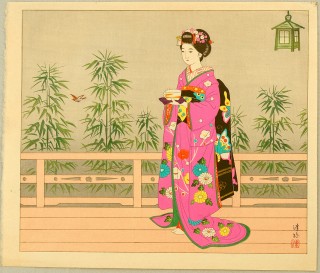The kimono and Japanese art

The Japanese civilization has largely been influenced by the Chinese history, as was the case for the European one with regard to the Greek and Latin classical era. Art, philosophy, all matters relating to tea do stem from the Chinese culture. The kimono, that reads “the thing (mono) that’s fit to be worn (kiru: to wear)”, is no exception: it is similar to the clothes used during the Tang Dynasty (618-907). Besides the essential line of the dress line, the sophisticated fabrics that it is made of and their patterns often inspired from the seasons, a remarkable feature of the kimono lies in the number of layers which it comprises. These decreased with time for practical reasons, but also perhaps for underlining the body that once was completely smoothed. A typical gentlewoman of the Heian era (794-1185) had longish hair (the epitome of beauty was reached when they were hanging on the floor), wrapped herself up with twelve layers of fabric and was constantly hiding behind fans and screens.
The described features can be applied for a successful reading of artworks: a painting dating back to around the Heian age or representing that period – specifically a scene from Genji Monogatari which is the first novel in the history of the Japanese literature – is identified because of the women using to wear long hair down and unwieldy clothing. By the way, the interiors were carefully designed for curtains, sliding doors and historiated screens to be invariably included and, in turn, miniaturized with a view to render a sort of attractive painting-in-painting décor.

Nowadays, the kimono gets rid of the Heian eve’s mo overgarment and hakama skirt pants, but is still, precisely since the Muromachi period (1392-1573), a multilayer clothing fitting steadily the body by a suitable belt (obi). Over the Edo period (1615-1868), the sleeves so elongate as to sway, thus becoming to some extent tools of seduction. It is still a common occurrence seeing unmarried girls who wear the furisode kimono, thus letting the long sleeves sway as a symbol of graciousness and youth. Apart from this funny usage, men and women of all ages wear kimono, even though the former, contrary to the latter as well as can be expected, are rather prone to use unsophisticated and handy ones.

The traditional kimono is currently worn in different circumstances, notably wedding, holyday, tea ceremony. Fashion designers made it suitable for the modern use with creating models whose decorative motifs are inspired by abstractionism or fauvism. The designer Jotaro Saito has made kimono casual through the creation of jeans-like models with fancy and transgressive patterns. But nevertheless, they draw inspiration from the camellia which is a traditionally auspicious flower, also used to make tea. There are also examples of fusion between Japanese and Italian culture, like the reversible skirt – kimono created by Aika Okochi and Marie Miyashita.
Copyright © arteingiappone – All rights reserved
The first image is taken from: http://www.artelino.com/articles/shoen_uemura.asp
The second is taken from: https://en.wikipedia.org/wiki/File:Ch5_wakamurasaki2.jpg